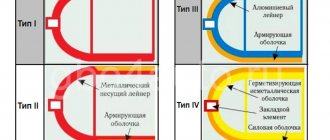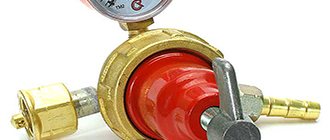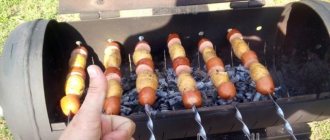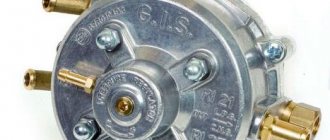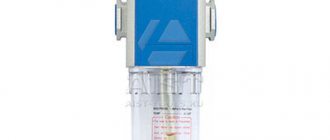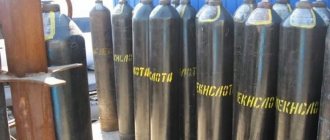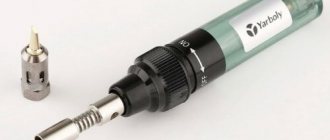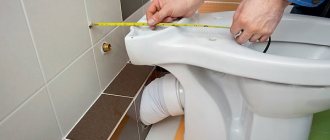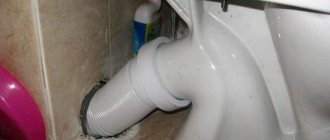Classification depending on the scope of application
Depending on the scope of application, reducers for gas cylinders are divided into several types:
- Household unregulated.
- Universal adjustable
- Professional.
Household unregulated
This type includes the simplest gearboxes used in domestic gas supply to households and in camping conditions. RDSG reducers are installed together with household gas cylinders. They have the simplest design, allowing the use of gas only in household stoves and are inexpensive and reliable. The frog reducer for a gas cylinder, or RDSG-1, is used in conjunction with containers from 12 to -50 liters.
For five-liter gas cylinders, popular among summer residents, tourists and hunters, the RDSG-2 Baltika model is used. The Baltika reducer is put on the nipple of the gas cylinder from above and fixed in the rubber seal with a special clamp. The gearboxes are configured for an operating pressure of 0.3 MPa and a throughput of 1.2 m 3 / hour
Universal adjustable
This class of gearboxes has a more complex design and wider capabilities. They can already be used both for domestic gas supply and for work in a home workshop. These reducers have a mandatory threaded connection to the gas cylinder, which securely locks the device.
Universal adjustable for propane with pressure gauge
They are also equipped with a pressure gauge and an adjusting screw that allows you to change the operating pressure from 0 to 0.3 MPa, depending on the needs of the gas consumer device connected to them. These devices also have a greater throughput than household ones - up to 5 m 3 / hour
Professional
This class is characterized by the use of more wear-resistant materials and better build quality and adjustment. The operating pressure adjustment parameters are also wider – from 0.4 to 1.6 MPa.
Professional gearbox with two pressure gauges
Some models are equipped with two pressure gauges - for inlet and operating pressure, respectively.
Jets for bottled gas
One important point must be taken into account: the stoves, originally designed to operate on mains natural gas, have jets (nozzles) that are not suitable for operation on bottled propane.
The jet is like a bolt with a hole in the top through which fuel flows to the burner. Bottled gas injectors have a smaller hole diameter because the pressure of liquefied propane is higher than that of natural fuel. Consequently, to connect such a stove to a liquefied gas cylinder, you will need to purchase and replace the entire set of nozzles.
USEFUL INFORMATION: Wall decoration in the kitchen: options
A new set will cost an average of 200 rubles. (the cost depends on the brand of the stove), it can be bought at a gas equipment spare parts store or ordered from the manufacturer.
If the jets need to be replaced, do the following:
- The burners and the burner table cover are removed.
- Using a hex wrench, the old injectors are removed and the new ones are screwed in.
You can understand all the nuances of the process of replacing jets by watching the video.
Features of using composite gas cylinders
Composite gas cylinders have recently become increasingly popular. This is due to their advantages over their steel counterparts.
- Weight. Almost twice as light as steel.
- Ease of handling. There are comfortable handles.
- Transparency. The fill level can be easily seen.
- Convenient storage. Can be placed one on top of the other and stacked.
- Life time. The service life is practically unlimited.
- Operational safety. It is caused by the absence of sparking and a safety valve and fusible link built into the gas cylinder.
Composite cylinders supplied to the Russian market are produced in the Czech Republic, Norway and India. When purchasing such a cylinder, it is necessary to clarify the connection standard. If the gas cylinder is equipped according to the Russian standard, you can use a regular reducer for the gas cylinder. If the gas cylinder comes with a European connector, then you will need to either order an adapter or purchase an imported reducer. Please note that each additional connection increases the risk of gas leakage.
Types of plates for gas cylinders
It’s worth saying right away that there are gas stoves that can work with both main natural gas and bottled liquefied gas. Reconfiguration requires replacement of nozzles and adjustment. So, in principle, any of them is suitable for a dacha.
Tabletop gas stoves are mobile... why not...
Another thing is that in “field” conditions it is used much less and less often than in everyday life. For this reason, the simplest and smallest models are chosen. After all, now water for tea is most often heated with an electric kettle, and prepared food is heated in a microwave oven. They only cook on the gas stove at the dacha, and even the simplest dishes. Some housewives also make twists. That's all. That’s why they usually buy one or two burner stoves. However, there is a fairly wide selection to suit any requirements and needs.
Table and floor
According to the installation method, gas stoves for dachas are divided into tabletop and floor-mounted. Technical characteristics do not differ only in dimensions. Desktop ones are usually made the simplest, without any additional options. This is exactly a country/hiking option with minimal weight and dimensions.
For rare visits, “this will do”, but you can’t place the cylinder next to it
Which gas stove is better for a summer cottage under a cylinder? Tabletop or floor-standing? It's all about the availability of free space. If you have somewhere to install a floor-standing option, take it. Even if they are more expensive, they themselves can serve as a cabinet. And there are usually not enough of them (cabinets) at the dacha. Just remember that you still need to find a place to store the cylinder. It can be located nearby (the minimum distance between the stove and the cylinder is 0.5 meters and at a distance of at least 1 meter from the heating devices), or it can stand on the street in a special cabinet that is locked with a key.
If, on the contrary, there is space on the table, but not on the floor, a tabletop version of a gas stove will do. The best part is that they cost one and a half to two thousand rubles.
Number and type of burners
A gas stove for a summer cottage under a cylinder can have from one to four burners. A single-burner is suitable if there are only one or two people at the dacha and you don’t do any twisting. To prepare breakfast/dinner for a family of three to four people and a small amount of preserves, two burners are enough. Well, if you need it and dinner for a full family, take it with three or four burners.
Options for tabletop gas stoves for a summer cottage under a cylinder
Recently, in addition to standard, medium-sized burners, they began to make even larger and smaller ones. This is convenient, since dishes come in different diameters. Such “excesses” are available only on four-burner options.
In addition, there are models that have electric burners in addition to gas burners. If there is light in the area, and you need a stove for your cottage with a cylinder for three or four burners, this is also convenient. The gas in the cylinder tends to run out at the most inopportune moment. If you don't have a spare one, at least start a fire. And if you have an electric burner, you can finish the process and hold out until the cylinder is filled.
Availability of additional options
The range of additional functions just for gas burners is small. These are electric or piezo ignition and gas control. Both functions are useful, but how necessary it is is up to you to judge. It’s worth saying right away that they are very rare in desktop versions.
Gas tabletop stove with electric oven underneath
Design features
There are only a few types of tabletop stoves. The simplest is one, more often two burners, and that’s it. But there are also models with a built-in electric oven. Not a bad option if you use an oven. This is where the species “diversity” ended.
Floor-mounted gas stoves for summer cottages have slightly more design options:
- With built-in gas or electric oven below.
- With shelves at the bottom.
- With a small cabinet and doors.
Two exactly “dacha” options
The cabinet under the gas stove can be used to install a small gas cylinder in it. This contradicts the requirements of gas workers (the distance between the stove and the cylinder must be at least 0.5 meters), but is still used.
Where can't you place the cylinder? In the basement or ground floor, in a residential area.
What is a propane reducer?
The design of all propane reducers is very similar. They all have:
- Sealed housing made of aluminum, brass or plastic.
- Inlet pipe for connection to the cylinder.
- Outlet pipe for connection to the consumer.
- High and low pressure chambers.
- Flexible membrane.
- Valve and stem.
- Return spring.
- Working spring.
In professional gas reducers, a pressure gauge, an adjusting screw or flywheel, and a threaded connection of the supply pipe are added to the design. The gearbox housing has a cylindrical shape, which is due to the use of a round membrane that bends inside the operating pressure chamber. The inlet and outlet pipes protrude from the housing.
How to choose a reducer for a household propane cylinder
To select a propane reducer for a gas cylinder, it is necessary to study and compare their characteristics. The most significant are:
- Purpose.
- Maximum inlet pressure, kg/cm3.
- Working pressure, kg/cm3.
- Maximum gas consumption, m 3 /hour.
- Connection standard.
- Planned service life.
- Price.
Depending on the planned application and the planned type of cylinder, one or another model may be the best choice. So, for example, if you plan to connect a tabletop gas stove in a garden house that you visit on weekends (or take it on a boat trip) and estimate your monthly gas consumption to be five liters, a five-liter cylinder and a Baltika RDSG-2 gas reducer are best suited.
Gearbox Baltika RDSG-2
For a stationary stove with an oven, you will already need a cylinder with a capacity of 27 or 50 liters and, accordingly, a Frog RDSG-2 gearbox.
If you want to connect a composite cylinder to a thermal umbrella, and both the cylinder and the umbrella have European connectors, then it makes sense to consider imported gas reducers with a KLF connector, for example, produced by the German company GOK.
If you plan to carry out gas welding in a home workshop, then a professional gas reducer BPO 5-3 Krass would be a good choice. It provides a maximum flow rate of up to 5 m 3 per hour and the ability to regulate operating pressure up to 0.4 MPa. To do this, it is equipped with an adjusting flywheel and a pressure gauge, which allows you to more accurately set the operating pressure in accordance with the needs of the gas welding torch or cutter.
Rules for the safe operation of propane cylinders
- When using and storing, do not allow the cylinders to overheat (for example, leave them in direct sunlight for a long time);
- It is not recommended to bleed out the propane-butane mixture until the tank is completely empty (under certain conditions it can suck in air, and this is dangerous);
- When transporting, be sure to use plugs and safety caps;
- in case of detection of dents or other defects, the product must be sent for an unscheduled recheck;
- Individuals are allowed to transport no more than five cylinders in one vehicle (they must be separated by spacers from each other).
- It is necessary to constantly monitor the condition of the cylinders, because it is not for nothing that they are considered fire and explosive objects.
What is the gas pressure in a propane tank?
According to GOST 15860-84, the working pressure in the tank should not exceed 1.6 MPa. In this case, the proportion of propane in the hydrocarbon mixture must be no less than 60%. This is very important for the safe operation of gas cylinder installations. Of course, products are designed for significantly higher pressures - more than 5.0 MPa. Production and periodic tests are carried out under a pressure of 3.0 MPa.
Refueling standards
At gas cylinder refilling stations, employees are familiar with the regulations. Since a cylinder that is filled too much can explode or its valve can be torn off. So, if you refuel from a reliable supplier, you have nothing to worry about.
| Cylinder type (l) | 5 | 12 | 27 | 50 |
| Maximum permissible quantity of propane, l | 3,5 | 8,4 | 18,9 | 35 |
Precautionary measures
Household gas is very dangerous. The main threats posed by propane are:
Reminder about domestic gas
- Fire hazard.
- Unsuitable for breathing.
- Explosion hazard when the maximum concentration of propane in the air is reached, as well as when the temperature in a closed volume rises sharply.
- During a gas leak, the temperature drops sharply and frostbite is possible.
Design features and maintenance
According to their design, gearboxes differ into direct and reverse acting devices. The differences between them are in the design details, the performance characteristics are identical.
Design of gearboxes for a gas cylinder
In addition, gas reducers are used in single-stage and two-stage types. In single-stage, the pressure is reduced in one stage. In a two-stage reduction, the reduction is carried out in two steps. Balloon single-stage reducers are most widely used due to their reliable design and ease of use.
Diagram of direct and reverse acting devices
Direct-type devices have the following operating scheme: propane entering the high-pressure zone presses the valve away from its seat. Propane enters the working chamber, filling it and increasing the pressure in it. It acts on the membrane, compressing the main spring. The membrane goes down, pulls the stem and closes the valve when the operating pressure value is reached. During the use of propane, the pressure in the working chamber drops, high-pressure propane opens the valve again and gas enters the working area again.
Direct action gearbox diagram
In reverse type devices, the valve is opened by the main spring, overcoming the force of the high pressure gas. After the working area is filled and the pressure reaches the set value, the rod moves down, closing the valve. As propane is used, the pressure in the working area decreases and the spring opens the valve again.
Reverse gearbox diagram
Reverse-acting devices are considered more reliable and safe. They have gained popularity in household and professional applications.
Operating principle of the gearbox
The device is connected to a gas cylinder using a union nut, the thread on which is strictly defined: Sp21.8LH (left). This is done in order to exclude the possibility of connecting a gearbox for other equipment. The connecting nut is made of brass and is necessarily equipped with a transition projection, which prevents possible gas leaks. When using propane cylinders manufactured according to the European standard KLF with an already installed sealing ring and a filter on the fitting, you will also need a special adapter.
A propane reducer works like this. The gas from the cylinder first passes through a mesh filter, from where it enters the lower chamber at high pressure. Next, the required operating pressure is adjusted. To do this, the adjusting screw is rotated clockwise, acting on the set spring. The spring pushes the pressure plate, and through the reducing spring, pusher and diaphragm transmits force to the reducing valve. It opens, and through the gap between the valve and its seat, it opens the way for propane into the working chamber. A low pressure gauge is used to monitor the actual gas pressure. In order to connect the hose of a roofing torch, cutter or other unit to the device, an outlet connecting nipple is provided. For connection, a union nut with an M16×1.5LH thread is usually used.
Typical faults and their repair
Deviation of the operating pressure from the specified one can be caused by the following reasons:
- Spring breakage or displacement.
- Depressurization of the housing.
Gas leakage is caused by:
- Membrane damage.
- Depressurization of the housing.
- Valve failure.
Some gearboxes are made collapsible. They are, in principle, available for self-repair. Non-separable gas reducers, of course, in the event of a malfunction must be replaced entirely.
Important! Remember that when disassembling the gearbox, you accept full responsibility for the consequences of its use.
So, for example, a home craftsman who has basic plumbing skills is quite capable of replacing a spring or membrane in an unregulated “Frog” gas reducer. A housing with a damaged seal cannot be repaired. In this case, the entire device will have to be replaced.
After replacing damaged parts with new ones from the repair kit and assembling the gas reducer, it is necessary to check its tightness using a soap solution.
Is self-connection allowed?
Almost all gas workers unanimously claim that connecting a propane cylinder to a gas stove should be done exclusively with their participation, having paid them money for calling a technician. However, this connection can be done with your own hands without additional costs.
There is nothing fundamentally complicated about this issue. Connecting a gas hob to a cylinder involves choosing a place for a container with fuel and organizing an outlet from there in the form of a pipe or flexible hose to the stove.
Whether the cylinder is connected to the stove yourself or by calling a gas fitter - according to the law, all responsibility for the safe operation of gas appliances lies solely with the owners or tenants of the residential building
To perform such work, you only need to have basic skills in handling wrenches. Plus, you will have to carefully study and fully comply with fire safety rules for gas-powered equipment.
A household propane cylinder can be installed both inside and outside a residential building. But fire safety standards recommend choosing a place to store gas outside, and not in the kitchen or utility room of the cottage. If installed outdoors, you will need to install a longer pipe or hose, but the likelihood of a fire and/or explosion will be less.
System connection standards
Devices that support two standards for connecting the reducer to a gas cylinder are widespread:
- GOST - common in the CIS countries, used on locally produced steel cylinders.
- GLK is a European standard, used primarily on composite cylinders.
Connecting the reducer to the gas cylinder
To connect the working pipe:
- Threaded connection.
- Nipples 6.3 or 9 mm.
- Universal nipple.
- GLK.
Some gas reducers, for example, RGDS, are equipped at the factory with a 9 mm nipple pressed into the housing.
Reducers with adjustable operating pressure are equipped with a threaded half-inch outlet, which can optionally be secured with a union nut and a universal nipple.
It is safer to use devices that match the standard. Each adapter is an additional connection that increases the risk of gas leakage.
Installation and startup procedure
In order to ensure fire safety, the following procedure for installing and starting up the equipment should be observed:
- Carry out a thorough external inspection of the container, gas reducer and pipelines and ensure that there are no visible defects or excessive heat.
- Connect the reducer to the gas cylinder.
- Connect the consumer device to the gearbox
- Open the cylinder valve slightly and listen.
- Open the gearbox valve (if present).
- Open the valve of the consumer device and start using it.
If there is a whistling or clicking noise, immediately close the gas cylinder valve.
Required pressure and volume
The key characteristics of a gas reducer are inlet pressure, operating pressure and flow rate, or the maximum volume of gas passing through the device in an hour.
The inlet pressure is determined by the standard pressure in the cylinders and is usually 20 MPa.
Technical characteristics of gearboxes
The operating pressure for household unregulated gas reducers is set at 0.3 MPa ±5%
For adjustable semi-professional and professional adapters, the operating pressure is set by the user in the range of 0-0.4 MPa, and for certain high-performance models - up to 1.6 MPa
The consumption volume must exceed the volume consumed by the device (or group of devices) per hour.
Cranes and other fittings
A gas valve must be installed at the point where the gas pipeline is connected to the stove, blocking the gas supply in the event of a malfunction of the stove. This can be either a ball valve with a yellow handwheel or a gas plug valve. The disadvantage of the latter is the need for periodic maintenance.
Another useful addition to a gas pipeline can be a flow meter. Its inclusion in the transportation chain will help to respond in a timely manner to the depletion of the mixture in the cylinder and replace it. The metering device does not have to have the outstanding accuracy necessary to monitor gas consumption in main networks; a device costing up to 2 thousand rubles will be sufficient.
When connecting several cylinders at the same time, a connecting ramp can be used. Its installation helps reduce the rate of gas evaporation from each cylinder and makes the risk of freezing the mixture in the reducer less likely. Installation of the ramp can be done independently using any gas pipeline material.
General rules for choosing a balloon reducer
Summarizing the rules for choosing a gearbox for a gas cylinder, it should be noted that:
Classification of reducers for gas cylinders
- it is necessary to sketch out a diagram of the planned system from the gas cylinder to the end user;
- clearly formulate the following requirements for the device:
- Purpose.
- Operating pressure.
- Need for adjustment.
- Maximum volume.
- Method of connection to a gas cylinder and to a working device.
- Availability of maintenance and repair.
- Allotted budget.
- From the variety of products on the market, you should choose those that meet the stated requirements.
- Next, you need to enter the models and their characteristics into the comparison table and conduct a price analysis.
If devices that meet the stated requirements do not fit within the allotted budget, then it is necessary to either revise the budget or simplify the requirements for the device.
Space for cylinder
Using energy resources is not a cheap pleasure. But if you choose between electricity and blue fuel, then the residents of our country prefer the latter. Natural gas is not just more affordable. Its cost is several times less than electricity.
And since gasification in the country is more or less established, our houses are mainly heated with blue fuel, and our kitchens have gas stoves. And only those buildings that have not yet been connected to a gas pipeline have to be content with electricity. But even in this case, there is always an opportunity to save money.
If there is no gas line, then household equipment can be connected to bottled fuel. Using heating, of course, will be unprofitable. But a kitchen stove powered by gas from a cylinder will be much more profitable than an electric burner.
Connecting a gas cylinder to a stove in the country begins with finding the right place to install the equipment. In this case, it is necessary to follow safety standards in order to avoid dangerous situations for the lives of others. Because liquefied gas has a high density and can quickly accumulate indoors.
A very dangerous neighborhood Source technosova.ru
In this regard, installation of a cylinder is prohibited:
- in living rooms;
- in spaces without ventilation;
- in basements;
- in rooms whose ventilation is connected to living rooms.
Most often, one of two options is chosen for a country house. The cylinder is placed directly next to the stove. The cooking room usually has a window. Therefore, the room can always be ventilated.
It is only necessary to maintain the distance from the gas cylinder to the stove. For safety reasons, it should be at least half a meter. You also need to make sure that the container does not come closer than a meter to the heating devices.
It would be more correct to install a gas cylinder at the dacha on the street. An iron cabinet is installed immediately behind the outer wall of the kitchen, which is installed on a wooden pallet. The internal dimensions of the box in height should exceed the standing cylinder by 20-30 cm.
The place must be equipped with a canopy. To avoid direct exposure to sunlight and avoid heating the container above +40 °C. Also, such a measure will help protect the system from water ingress. And for those who are going to use bottled gas in winter, you will need to either properly insulate the cabinet or use a special frost-resistant mixture.
Fuel container in a special outdoor cabinet Source lenbyt.ru
Area of application of devices
Wherever there is no stationary gas distribution, people use propane in cylinders. And each cylinder is connected to one or another reducer. The most popular applications are:
Using the gearbox for soldering and welding
- Household and portable stoves and grills.
- Gas water heaters and heat guns for heating rooms.
- Thermal umbrellas for heating recreation areas.
- Gas cutters and welding torches.
- Fuel for land and river transport.
In many countries, wide gas distribution networks have been created to ensure recharging and delivery of gas cylinders to consumers.
The gas cylinder reducer ensures safe and stable operation of gas consuming devices.
If you find an error, please select a piece of text and press Ctrl+Enter.
As is known, liquefied hydrocarbon gas (propane-butane) is stored in cylinders or gas tanks under a pressure of several bar. To reach the operating parameters of consumers (30-50 mbar), a special device is used in autonomous gas supply systems for private facilities - a household propane reducer . If we draw an analogy with an electrical network, this device acts as a stabilizer, that is, it reduces the pressure to the required value and automatically maintains it at the same level.
Reducer for gas cylinder
Since we are choosing a reducer for a gas cylinder, we consider it necessary to touch upon the topic of the container itself. The technological process and widespread introduction of new innovative materials are bearing fruit. You can increasingly find new composite cylinders on the market, replacing the old generation. Modern models, unlike outdated predecessors, have less weight and offer a greater level of safety. The latest manufacturing technologies undergo multi-level testing; at testing sites, the composite cylinder is subjected to an explosion, but even after such tests you will not find small fragments.
Read also: How to cook thin iron correctly
Composite cylinders are not subject to internal corrosion, are lightweight and comfortable. However, they do not know how to supply gas evenly on their own. A filled cylinder, of course, produces more powerful pressure than a half-empty one. A gas regulator will come to the rescue; its task is to regulate the pressure at the outlet of the composite cylinder and maintain it at the required level throughout the entire period of use.
Gas pressure reducers that have passed European certification show good collaboration with composite cylinders. Let's highlight one of these devices: the household gas reducer A300i-A310i IGT. The positive aspects include the following characteristics of the product:
- the presence of a nut that can be tightened by hand;
- service life of the control membrane increased to 10 years;
- the design ensures maximum sealing of the connecting elements;
- the gas hose on a fitting without a thread is clamped with a clamp.
Despite the fact that the importance of the device in creating conditions for the safe operation of a stove or other device is difficult to overestimate, household reducers for gas cylinders are usually sold at an acceptable cost. Despite the fact that the price rarely exceeds 300-400 rubles, these devices can protect not only your home, but also your life from dangerous situations.
Choosing a gas pressure reducing device is not a complicated process, but you should know and take into account such details as:
- The name of the gas passing through the device;
- Characteristics of the cylinder;
- Dimensions, type of flexible gas supply;
- Required flow and outlet pressure;
- Connection method.
Design and principle of operation of the gas reducer.
Any propane reducer contains the following components:
- valve;
- working chamber;
- locking spring;
- compression spring;
- membrane
The throughput of this device depends on the degree of opening of the valve, which is influenced on one side by a membrane and a pressure spring, and on the other by gas and a shut-off spring. The higher the propane pressure in the cylinder and the lower the flow rate of gas-using equipment, the closer the valve is located to the seat. Conversely, as the pressure in the chamber drops and the flow rate increases, the valve opens more. The operating parameters of a household propane reducer are determined by the stiffness of the springs and the elasticity of the membrane. Some models are additionally equipped with a valve, the shaft of which is connected to a pressure spring, which allows you to manually regulate the gas supply within a certain range.
Operating principle of the device:
Modern propane reducers are sometimes additionally equipped with a safety mechanism that is triggered if the inlet pressure of propane-butane is exceeded. In order to increase the level of safety, such reducers are usually installed on gas tanks and group cylinder installations used for gasification of one or several houses. You can learn more about how autonomous heating is implemented in private households from the article: Autonomous heating with propane butane.
Cranes and other fittings
A gas valve must be installed at the point where the gas pipeline is connected to the stove, blocking the gas supply in the event of a malfunction of the stove. This can be either a ball valve with a yellow handwheel or a gas plug valve. The disadvantage of the latter is the need for periodic maintenance.
Another useful addition to a gas pipeline can be a flow meter. Its inclusion in the transportation chain will help to respond in a timely manner to the depletion of the mixture in the cylinder and replace it. The metering device does not have to have the outstanding accuracy necessary to monitor gas consumption in main networks; a device costing up to 2 thousand rubles will be sufficient.
When connecting several cylinders at the same time, a connecting ramp can be used. Its installation helps reduce the rate of gas evaporation from each cylinder and makes the risk of freezing the mixture in the reducer less likely. Installation of the ramp can be done independently using any gas pipeline material.
How to choose a household propane reducer
The choice of a device for supplying a propane-butane mixture to gas-using equipment is based on two key parameters:
Sample passport for a gas stove
The operating mode of most household propane appliances is 30 mbar, 37 mbar or 50 mbar. Based on this indicator, the appropriate gearbox is selected. If its output pressure differs from the operating parameter of a gas stove, boiler or, for example, a grill, this may lead to improper operation of the equipment and even create an explosive situation.
The characteristics of the propane reducer can be seen on it - 3 kg/h and 29mbar
30 mbar, 1.5 kg/h (kg/h)
For stable and safe operation of the gas consumer, it is also important that its consumption does not exceed the performance of the gas reducer. In this case, the upper level of gearbox consumption is not standardized. That is, for a boiler with a power of 24 kW with a mass flow of 2 - 2.5 kg/h, it is permissible to install a gearbox with a capacity of 3 kg/h and higher - the automatic boiler or stove will still not allow “extra” gas to pass through.
0.45 m3 (for propane - butane)
1000 Pa - 1 kPa - 10 mbar
30 mbar - 0.03 bar
Some owners of autonomous gas supply systems make the mistake of purchasing industrial gearboxes instead of household ones, considering them more reliable. Firstly, such devices are an order of magnitude more expensive, and secondly, they are designed to work with more powerful gas equipment, so they are not always compatible with household appliances.
You should also pay attention to the type of thread of the device. Gearboxes designed to work with non-flammable gases are equipped with a right-hand thread, and with flammable gases they have a left-hand thread and a mark on the nut.
How to connect a gas stove to a cylinder
For various reasons, sometimes it becomes necessary to operate a gas stove where there is no centralized gas supply.
For example, you took an old stove to the country house and want to use it there, but there is no gas supply in the house.
In this case, cylinders with liquefied fuel come to the rescue; users are interested in only one question: how to properly connect a gas stove to a replacement cylinder, and what needs to be purchased for this.
Necessary equipment
The list of everything needed to properly connect a gas cylinder with liquefied blue fuel looks like this.
- A working stove, although not new, but all the burners are intact and intact.
- Reducer for the cylinder - you must buy it with threads and nuts made of brass, for fire safety reasons, with a pressure of at least 30 mbar.
- The gas hose must be selected one and a half meters more than the actual distance to the storage location of the cylinder in order to eliminate its tension when connecting.
- Various connection devices - this applies only to old products; new gas stoves are equipped with everything necessary.
- A copper-plated tool, so as not to accidentally create a spark when it falls or comes off the nut (such are the requirements of the rules for working with gas equipment, and they should not be neglected).
- To seal all joints, ordinary fum tape or flax tow is suitable.
- For a propane gas cylinder, it is best to install a special iron box, which should be locked with a key, especially if there are small children in the family.
- After completing all the work, you will need a soap solution, which must be used to treat all connectors and each connection, as well as the handles of the gas stove - this is done to detect gas leaks.
Very important! To connect a liquefied propane cylinder to a gas stove, you can only use a new special hose, and not an old one from the garage: even with proper storage, it may have internal microcracks.
Work algorithm
The first step is to decide where the gas cylinder will be located; there are three types of correct installation.
- Outside a living space, in the yard, in a special metal box - fire inspectors will thank you.
- The first option is not always possible, so they install the cylinder in the pantry next to the kitchen, and drill a hole in the common wall for the hose.
- If there is no other place, but only in the immediate vicinity of the stove, then it is placed no closer than 1 meter. For safety, you need to build a mount made of wood or buy a special metal cabinet.
Important! The rules for using gas equipment allow the installation of a shielded gas container no closer than half a meter from the stove without additional fences.
Users should also be aware that a mixture of propane and butane is pumped into the cylinders, which is heavier than oxygen, and according to the laws of physics, such fractions can accumulate in unventilated areas - therefore, such equipment should not be installed in basements.
Connection to plate
This is the safest work, regardless of where it is performed - at the dacha or in the urban private sector, because the gas has not yet been connected, so there is nothing to fear. If there is a threaded connection, then we wrap the sealing tape around the thread and tighten the nut until it stops. Before doing this, you need to check the presence of an O-ring inside the nut on the hose, as shown in the photo.
Connecting the cylinder
All commercially produced gas stoves are designed to use fuel at low pressure, so when connecting the cylinder to the stove, you need a reducer that will provide it.
This product is installed on a cylinder; the thread is left-handed, so it must be screwed to the left, and not according to the pattern familiar to many users. For safety, all nuts and threaded connections are made of brass.
Connection is made after careful inspection of all parts:
- there should be no dirt or dust, especially on the threads and inside the nut, on the gearbox and gas container;
- the main attention should be paid to the hose - it must be of the required length with a margin, have no signs of mechanical damage or cracks, and the period of use must correspond to the installation date;
- All clamps must be new, it is better to use them with an anti-corrosion coating, for durability, taking into account the temperature difference in the autumn-winter period.
After completing the work on connecting the cylinder, we perform a visual check of the correct connection, and only then begin the final stage.
Check for leaks
Now it's time to use a pre-prepared solution of water and soap. We carefully open the valve on the gas container - a hissing sound is heard, which confirms the proper function of the gearbox. Now we take soap foam with a soft foam sponge and apply it to all connections - if bubbles appear, you need to tighten the nuts.
If the foam remains motionless, it means that the quality of the connection is excellent, and there is nothing to worry about; you can turn on the stove and check the stability of combustion.
Perhaps insecure home craftsmen will find this video useful:
A little about gas cylinders
They are usually made of metal, but the industry does not stand still - today special containers made from the following components are already on sale:
- very easy to use, lightweight, explosion-proof products made from fiberglass threads with the addition of epoxy resin;
- cylinders made of a symbiosis of metal and composite materials.
Such containers are designed for a capacity of 5-50 liters; at dachas they are connected to stoves, gas heating boilers, smokehouses, and special installations for grilling or barbecuing.
Cylinders should be refilled only at special stations, where condensate must also be drained from the inside.
We must remember that only 40 liters are pumped into a 50-liter cylinder, so the price should be appropriate.
If the stove is not in use, then the valve must be tightened; the same operation must be performed when changing cylinders.
It is better if the connection of the gas cylinder, as well as the connection of the stove to the gas pipeline, is carried out by a gas service specialist.
How to install an LPG reducer - five secrets to avoid problems in the future
- The installation of the gearbox must be carried out according to certain principles and rules that cannot be violated. For example, the gearbox must be installed strictly parallel to the movement of the vehicle in a vertical position. The gearbox mount must be reliable and rigid; as a rule, it is a bracket that is attached to the body.
- You should also remember about the condensate drain fitting, which should be the lowest point of the system, at the same time free access to it should be provided. It is not recommended to install the gearbox above the upper level of the engine cooling radiator.
- When installing, make sure that the solenoid valve is not in contact with the body. Try to install the reducer closer to the mixer, this will increase the efficiency of gas equipment, as well as the safety of the system as a whole.
- The connection of water cooling to the gearbox is realized using lines and various tees. Coolant circulation occurs as follows: antifreeze is supplied to the lower fitting, after passing through the cooling channels, the liquid exits back into the engine cooling system through the upper fitting. In order to prevent overheating of the gearbox and undesirable consequences, monitor the coolant level.
- The solenoid valve must be securely mounted in a vertical position with the solenoid pointing upward.
Camping gas stoves
Their difference lies not only in their low weight, but also in the fact that they use gas in aerosol cans, which weigh from 200 to 500 g. Tourist stoves are equipped with wind protection for the burner. Expensive models have closed ceramic burners, which protect people from burns and protect the fire from bad weather.
How to connect large format gas cylinders to a portable stove? To do this, some devices include a propane hose and a miniature reducer. The 5-liter cylinder does not take up much space and can be taken with you on a car trip.
